Spring 2021 Newsletter
published 19 Jul 2021 by Fort Folly Habitat Recovery in News category with 0 comments
published 19 Jul 2021 by Fort Folly Habitat Recovery in News category with 0 comments
Contents
The Fort Folly Habitat Recovery Program is focused on restoring traditionally important species and their habitats, especially the critically endangered inner Bay of Fundy Atlantic salmon. The program was initiated in 1993, focusing mainly on restoration projects surrounding local environmental issues. These included the restoration of local streams such as the Back Brook Dam in Dorchester, cleaning up of illegal dump sites around the local community, and construction of nesting boxes for various bird species. In 1998, the first meeting for the Inner Bay of Fundy (iBoF) Atlantic Salmon Recovery Team was held in conjunction with the Department of Fisheries and Oceans for species at risk. During this time, the Live Gene Bank (LGB) was established to rescue remaining iBoF Atlantic Salmon at Mactaquac Biodiversity Facility (MBF) for reproduction survival and in 2001, COSEWIC (Committee on the Status of Endangered Wildlife in Canada) listed the iBoF Atlantic Salmon as endangered. Since 2001, the FFHR Team has been involved with recovery actions on numerous iBoF rivers including the Big Salmon River, the Petitcodiac River and its tributaries (the Pollett & Little Rivers) and the Upper Salmon & Point Wolfe Rivers in Fundy National Park. As the lead for salmon recovery on the Big Salmon River and Petitcodiac watershed, we have partnered to become part of what is now known as Fundy Salmon Recovery. This is a unique collaboration of First Nations, industry, academia, provincial and federal governments.
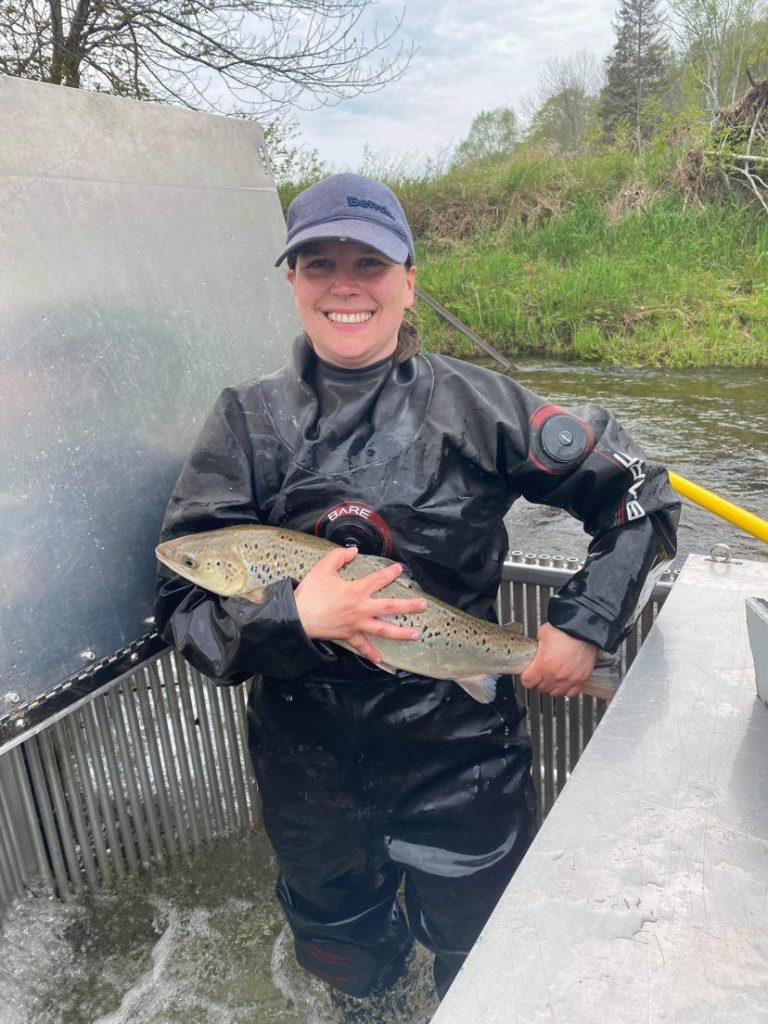
Although a variety of methods were used to fish the Pollett River this year, the primary method used was a counting fence. A V-shaped fence was installed across the width of the river, directing fish into a trap in the centre where they were held until technicians arrive. Fishing began on April 22nd and ended on June 4th, with a total of 498 smolts captured. 338 of these smolts were retained for Fundy Salmon Recovery. 145 smolts were given a small mark on their caudal fin (tail) and released upstream as part of a mark-recapture study to determine the efficiency of our trap, and 23 of those fish were caught a second time. In addition, data such as length and weight as well as tissue and scale samples were taken from a fraction of smolts encountered.
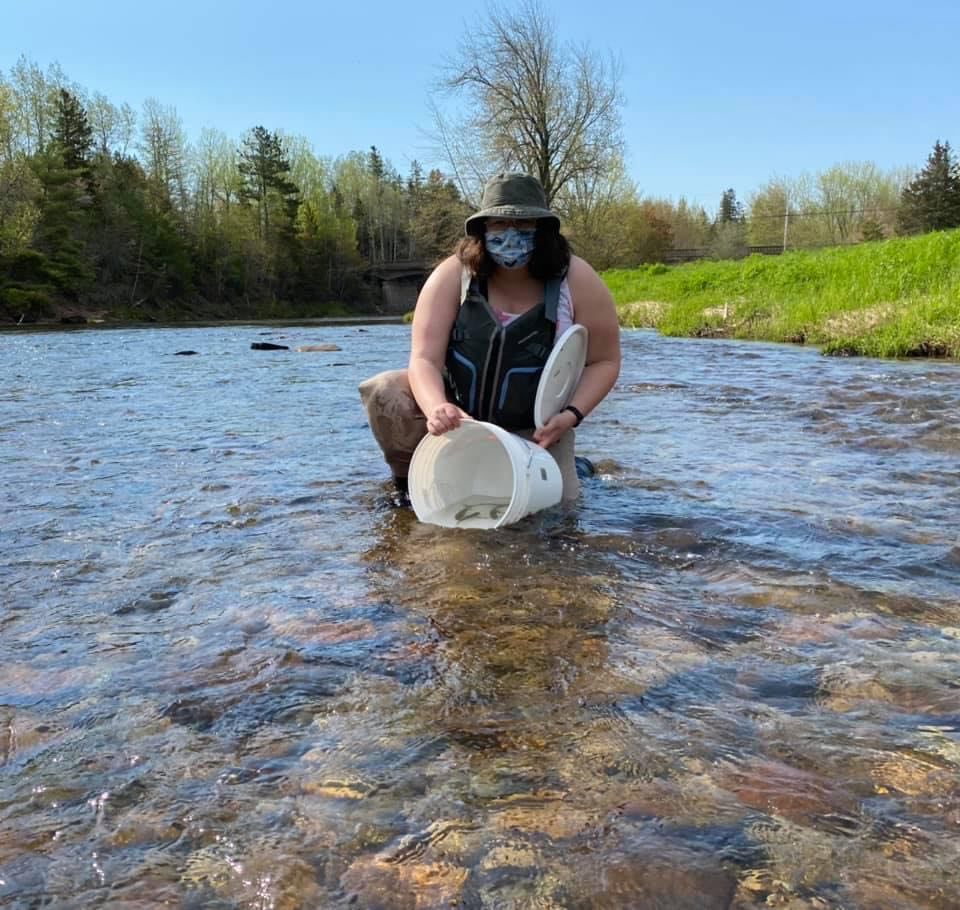
Along with salmon smolts, four adult salmon were encountered at the Pollett River this season. These salmon were previously caught by our program as smolts, and later received a Passive Integrated Transponder (PIT) tag before being released back into local watersheds. Using this PIT tag, we were able to determine information such as the date and location that these fish were caught as smolts as well as their length before release. In addition to this, many other species were also encountered including American eels, gaspereau, sea lampreys, brown bullheads, brook trout, white suckers, and shiners.
The adult salmon pictured in the photo below was captured on May 24th, 2018 as a smolt on the Little River. At the time, it was only 15.5 centimeters in length! The smolt was transported to the Fundy Salmon Recovery conservation farm and grown to maturity. This salmon was tagged as a mature female in 2020 at 58 centimeters, and was released on October 15th, 2020.
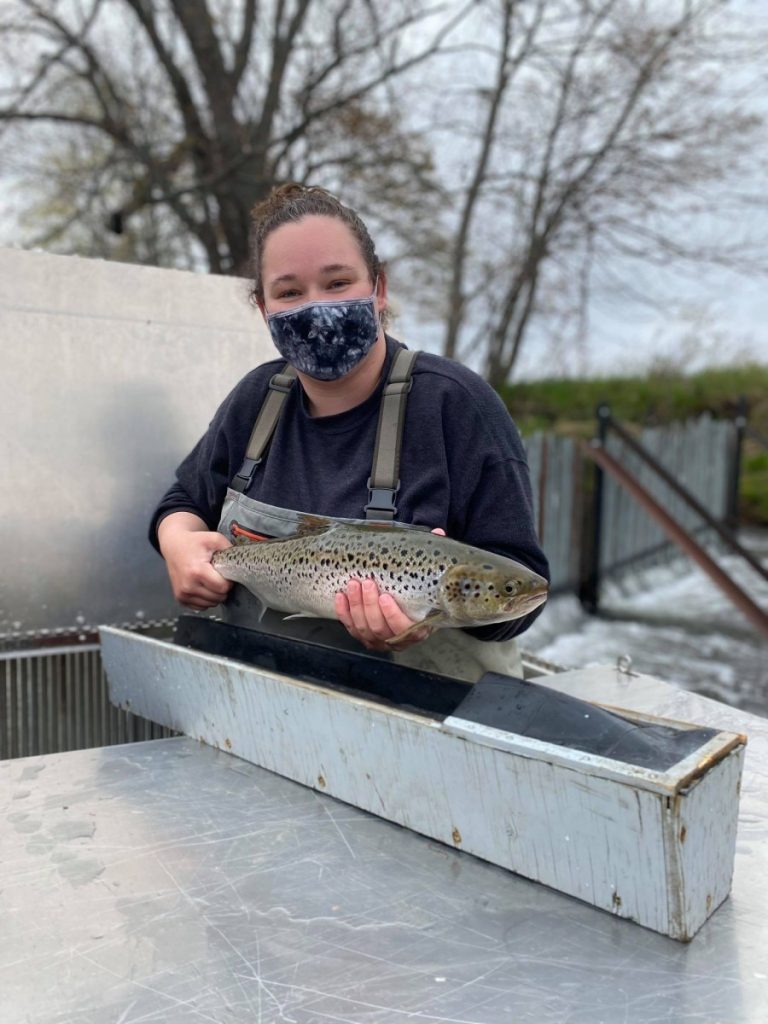
smolt wheel, also known as a Rotary Screw Trap (RST), is designed to catch a portion of the springtime juvenile salmon who are migrating out to the sea for the first time. Any salmon which swim into the smolt wheel are held and unharmed within its ‘live-well’ until technicians arrive to sample them. A percentage of those fish captured are held for transport to the Live Gene Bank (LGB) at the Mactaquac Biodiversity Facility, where representation of surviving iBOF Atlantic salmon families is being maintained. Another percentage of captured fish were allocated for transport to the Fundy Salmon Recovery conservation farm. This year, data such as length and weight, as well as scale and tissue samples, were collected from only a fraction of salmon caught. The fish which were sampled were also marked using an upper caudal punch and recycled upriver to be recaptured by the smolt wheel once again. This mark-recapture method allows for trap efficiency to be calculated, allowing us to estimate the size of the run.
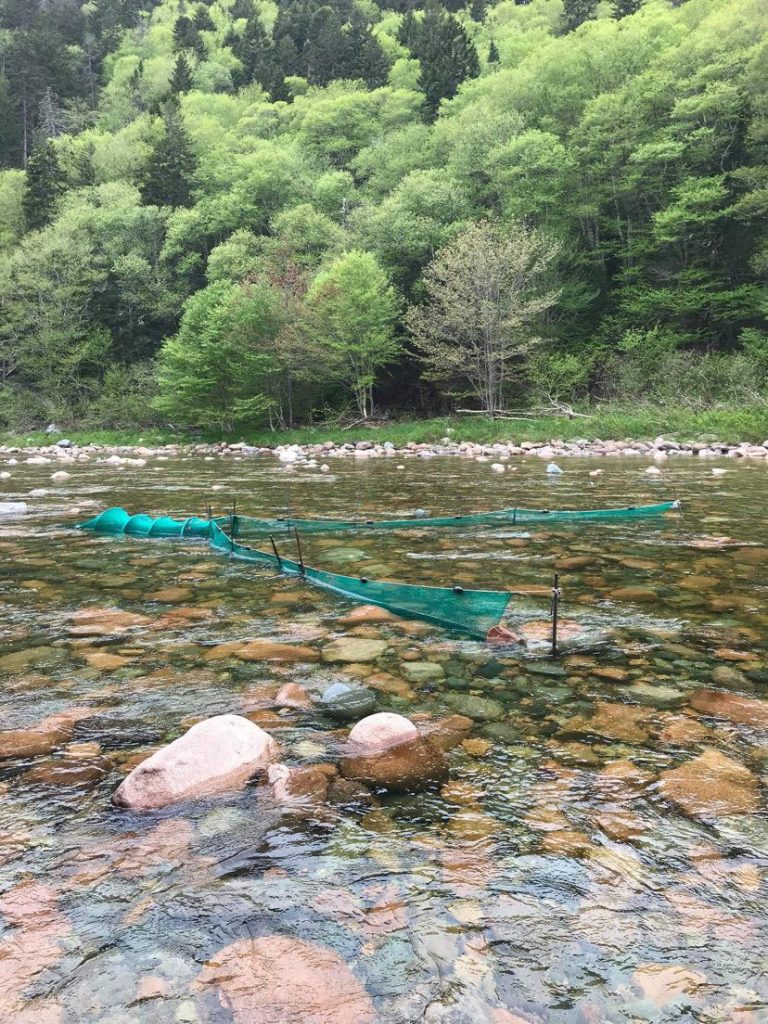
The RST was operated in collaboration with Fisheries and Oceans Canada with fishing occurring 7 days a week from May 3rd to June 11th. In addition to the RST, a fyke net was installed on the Big Salmon River on May 30th in an effort to increase our daily smolt catches. The fyke net was operational 5 days a week. This year’s total smolt catch on the Big Salmon River was 242. Of these, 81 were sampled and recycled, 35 were transported to Dark Harbour, and 117 were transported to Mactaquac Biodiversity Facility. The remaining 9 smolts were released for various reasons, including previously spending time in a hatchery. Along with Atlantic salmon smolts, our team also encountered other species such as American eels, brook trout, rainbow trout parr, and amphibious species such as spotted salamanders.
Smolt operations on the Big Salmon River would not be possible without continued support from New Brunswick Wildlife Trust Fund.
The Fish Net Trap (FNT) is operated by Fort Folly Habitat Recovery for Wood Environment and Infrastructure on behalf of the Province of New Brunswick. This is part of required monitoring according to the terms of the regulatory approval for building the new bridge linking Moncton and Riverview to partially replace the Petitcodiac Causeway. The FNT is located in Salisbury at the head of tide on the Petitcodiac. The trap targets anadromous fish species coming upstream as they enter the freshwater portion of the Petitcodiac River from the estuary. The purpose of this activity is to assess the results of changes being undertaken in the river. The first was the opening of the gates in 2010. The second is completion of the bridge in 2021. The goal of both actions has been restoration of fish passage in the Petitcodiac, particularly with respect to inner Bay of Fundy Atlantic salmon. Monitoring at the FNT provides insights into how the community of fish in the Petitcodiac are responding to these changes.
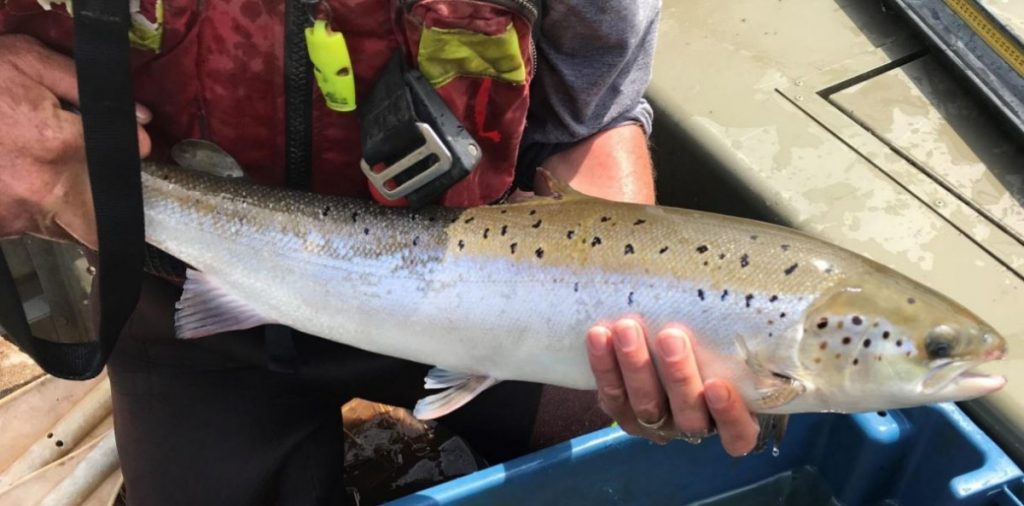
Fish captured at the FNT are for the most part simply tallied and released, with two exceptions. The first exception is species of particular interest such as trout, salmon, striped bass, and eels, which are measured, and (depending upon the species) may be photographed, sampled, or tagged. The second exception is invasive species such as smallmouth bass and chain pickerel, which are euthanized.
Other invasive species that have been observed at the FNT are goldfish (2019) and brown bullhead. Approvals are now in place to euthanize goldfish as well, though none have been seen since 2019. Our license does not permit euthanizing brown bullhead because, unlike the other invasive species, brown bullhead do not pose much threat to desirable native species.
This year, our annual fry release occurred on June 7th. Approximately 168,000 unfed fry were transported from Mactaquac Biodiversity Facility (MBF) to be released. These juveniles will grow in the river, and a portion will be collected as parr in fall 2022. These parr are overwintered at MBF and the resulting smolts are later transported to Fundy Salmon Recovery’s conservation farm in Dark Harbour, Grand Manan. Those which are not collected as parr may develop into smolts in the river and be caught in future smolt seasons.
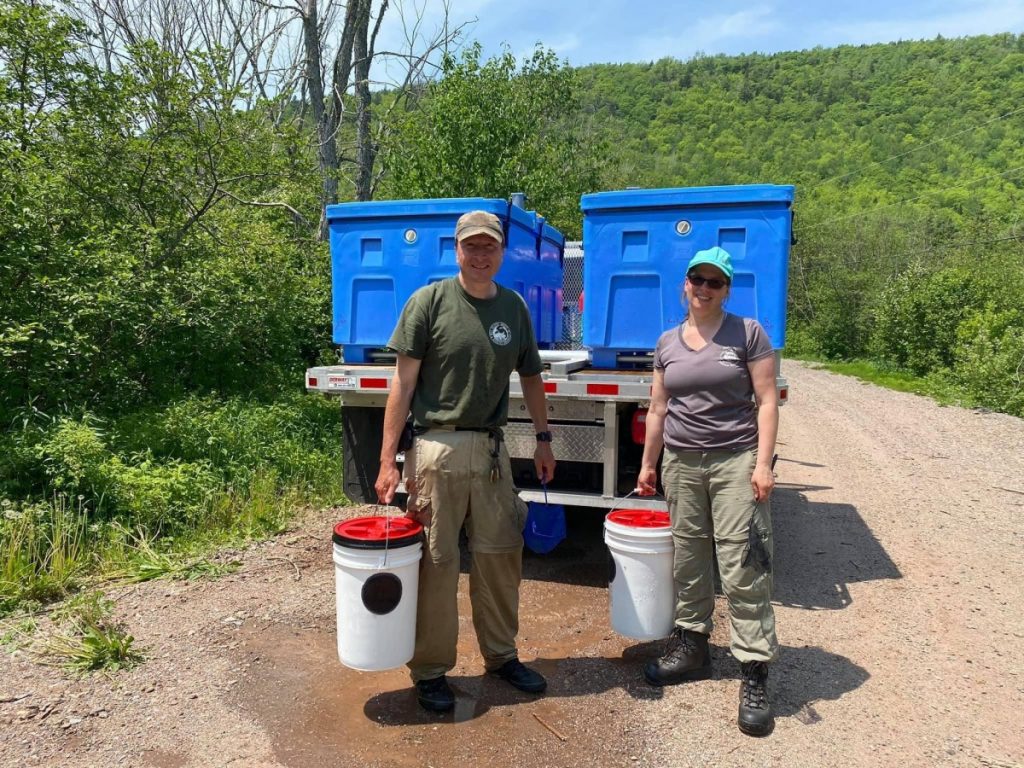
Our annual fry release would not be possible without the continued support from Atlantic Salmon Conservation Foundation.